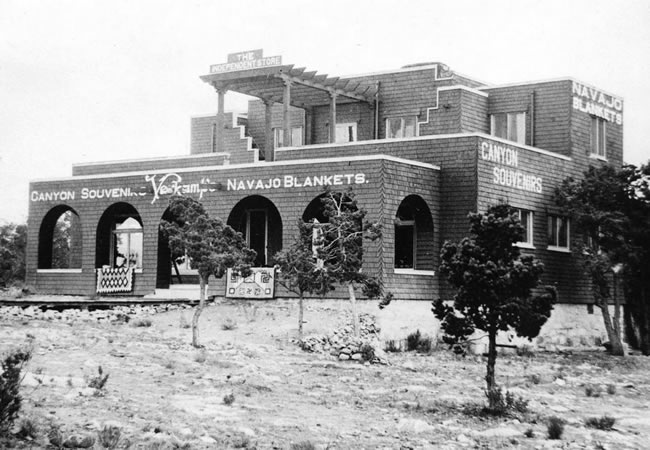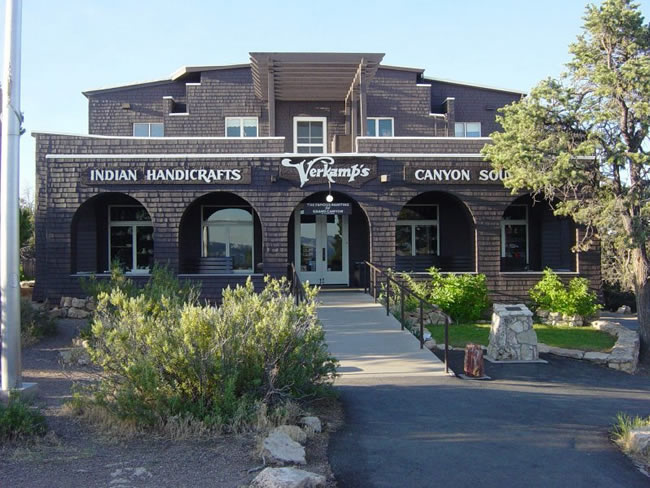People from across the United States have come to the Grand Canyon as visitors, but they have also come to develop businesses or provide services to others, in the process making the Grand Canyon their home. In the American tradition of moving westward to seek out new economic opportunities, in 1898 Ohio native John George Verkamp rented a tent on the grounds of the Bright Angel Hotel and opened the first curio shop at the Grand Canyon as an agent for the Babbitt Brothers’ Trading Company, selling Native American crafts and other souvenirs to passing tourists.
Verkamp and the Babbitts both came from Cincinnati, Ohio, where they had lived across the street from each other. In fact, three of John’s sisters had married three of the five Babbitt brothers. Four Babbitt brothers had come to Flagstaff, Arizona, in 1886, where they established a cattle ranch and mercantile store. Since few early settlers had much cash, many of the manufactured goods that the Babbitts sold were bartered or traded for items such as Native American pottery, baskets, rugs, and silver jewelry. The Babbitts saw an opportunity to expand their economic interests by reselling these unique local crafts to the slowly growing number of tourists at the Grand Canyon, since there were no other nearby stores where they could purchase such goods. Verkamp was the man they chose to run this new operation.
Unfortunately for Verkamp, there were not enough tourists at the time to make a profit, so he closed his store after only a few weeks. However, in 1905 he returned to the Canyon after the Santa Fe Railroad had reached the South Rim, and the first-class El Tovar hotel opened its doors. Verkamp realized that this would probably mean a lot more tourists, especially wealthy ones, would visit the canyon and probably want to buy mementos of their off-the-beaten-track vacation. He quickly constructed Verkamp’s Curios, completed in 1906, which still stands at its original location about 100 feet from the rim.
Verkamp eventually brought his wife, Catherine, and their four children to live at the Canyon and help him operate the store. The family-run business competed with nearby Hopi House, which the Fred Harvey Company owned and operated. Like Hopi House, the Verkamps sold Native American arts and crafts and other luxury items, but they also sold souvenirs such as postcards and trinkets that anyone could afford. They were able to make a profit by purchasing directly from Native American artists and using mostly family labor.
The unusual architectural design of Verkamp’s Curios is sometimes described as a modified Mission style. Though this style does not blend in well with the local environment, it did include accommodations to the aridity at the canyon: wooden shingles on the roof that conduct rainwater to a cistern under the porch, which the family used as its water supply since there is no significant natural water source on the South Rim. The main floor held the curio shop and storage rooms, while the second floor served as the family’s living quarters through 1978.
John Verkamp passed away in 1944, technically ending the family’s concession contract with the park. Park officials coveted this prime location, envisioning it as a spot for a new Fred Harvey hotel and casino. They hoped to take control of the site and remove the building, which they viewed as “unsightly.” However, John’s wife and children convinced the park to renew their contract. Eventually, officials recognized that the structure had historic value, and efforts to demolish it halted in the 1970s. The store was listed on the National Register of Historic Places in 1974.
In 2006, the store celebrated its 100th anniversary. After four generations of ownership, the family had hired managers and employees to handle day-to-day operations but a family board still governed the business, making it the oldest family-owned concession in the entire National Park System. As long-time residents, the Verkamps were important figures in the Grand Canyon Village community. They played an important role in creating the Grand Canyon School for children of National Park Service employees, and supported the local Boy Scout Troop. Family members assisted at the community library and helped found the local Rotary Club. However, in 2008, the Verkamps chose not to apply for a new concession contract and closed their business. The National Park Service took over the building and converted it into a visitor contact station and museum that includes a Grand Canyon Association bookstore.
Written By Sarah Bohl Gerke
References:
- Anderson, Michael F. Living at the Edge: Explorers, Exploiters and Settlers of the Grand Canyon Region. Grand Canyon Association, 1998.
- Anderson, Michael. Polishing the Jewel: An Administrative History of Grand Canyon National Park. GCA, 2000.
- Anderson, Michael. Along the Rim: A Guide to Grand Canyon’s South Rim from Hermit’s Rest to Desert View. GCA, 2001.



